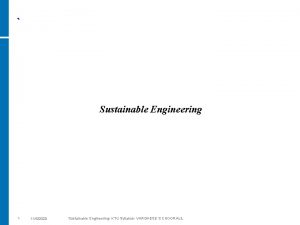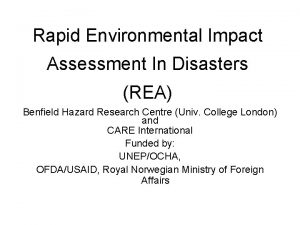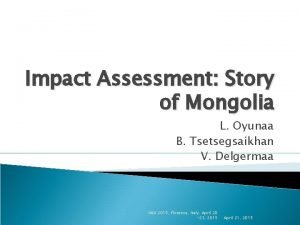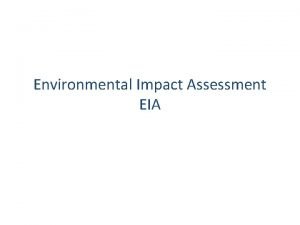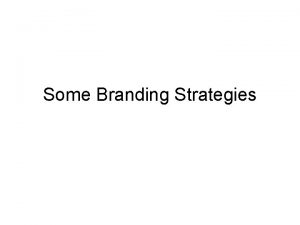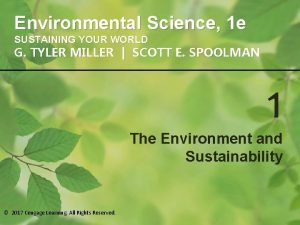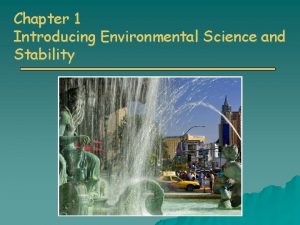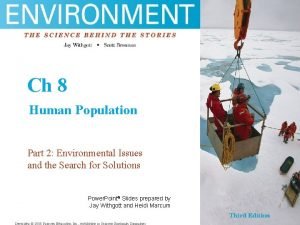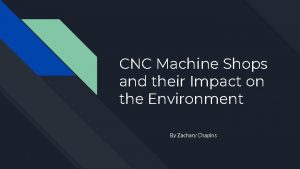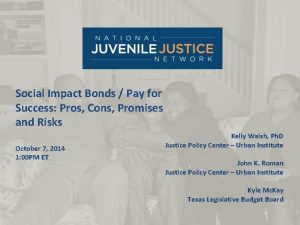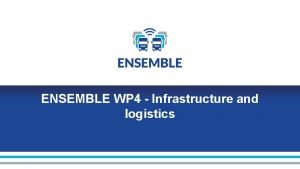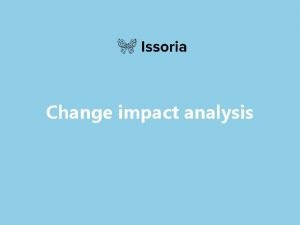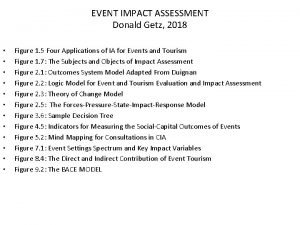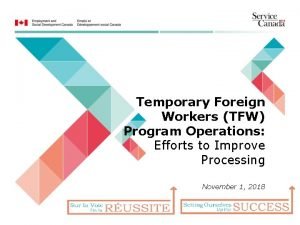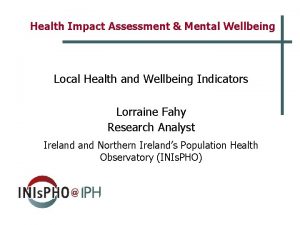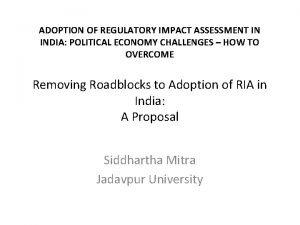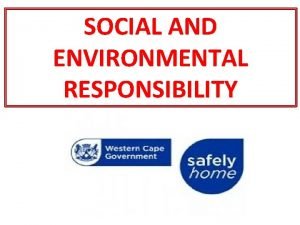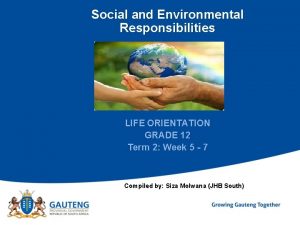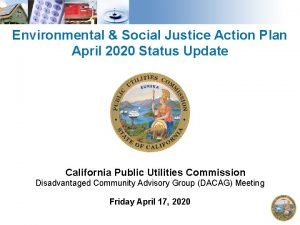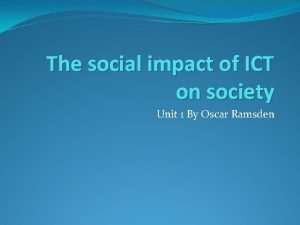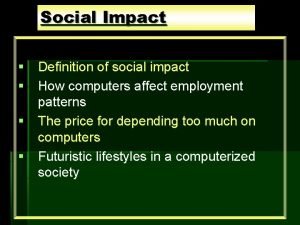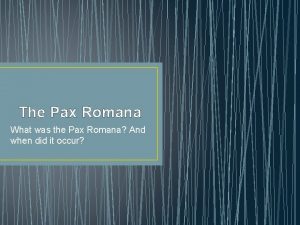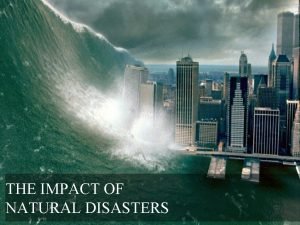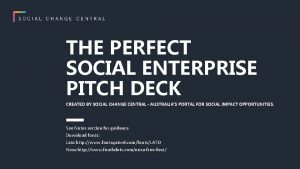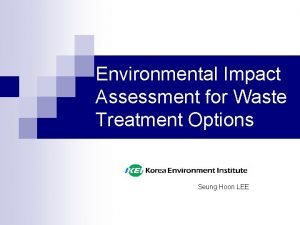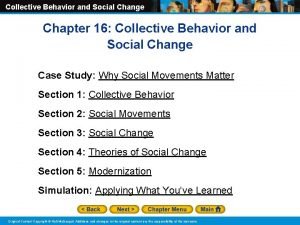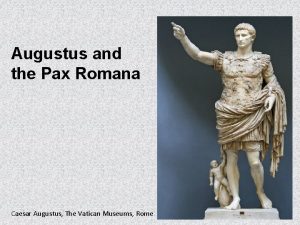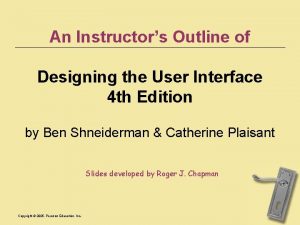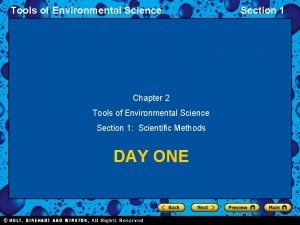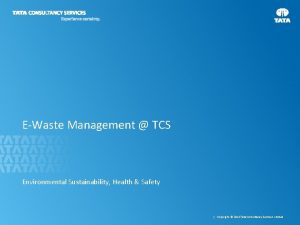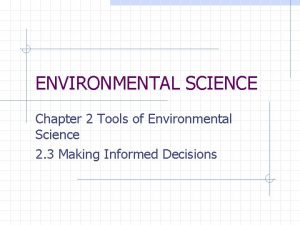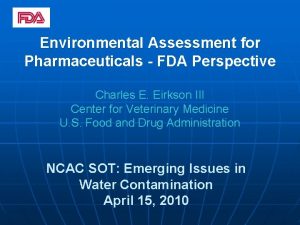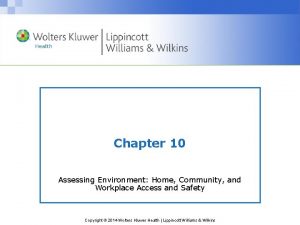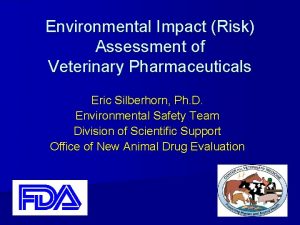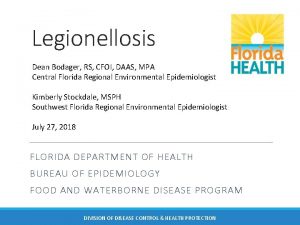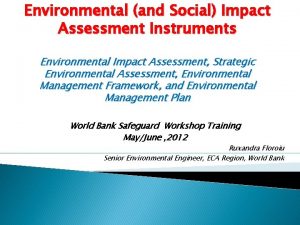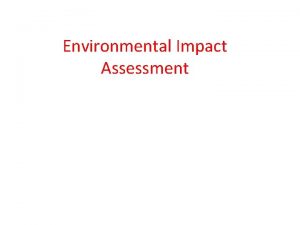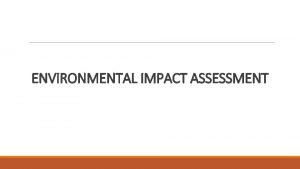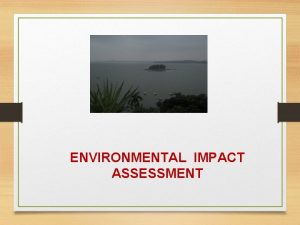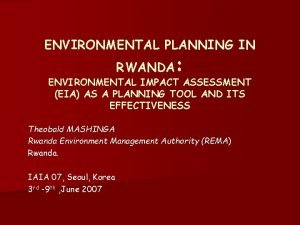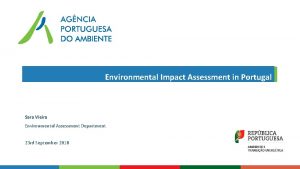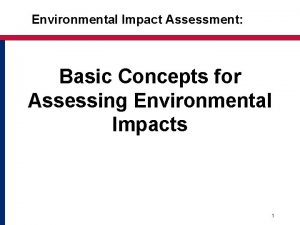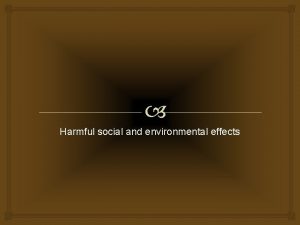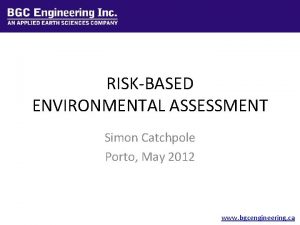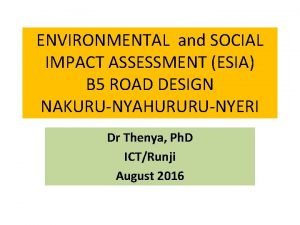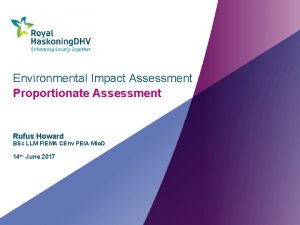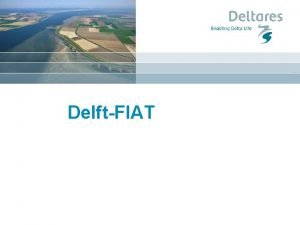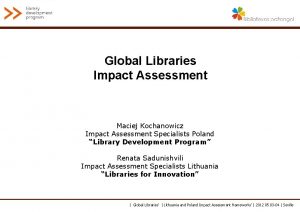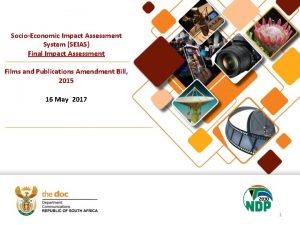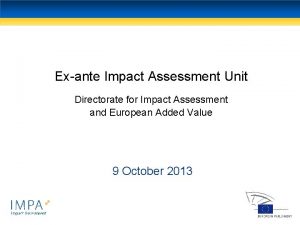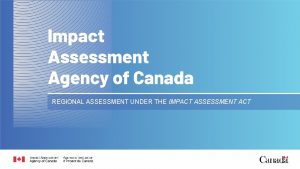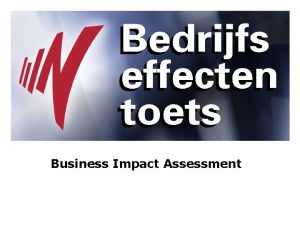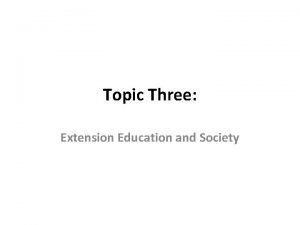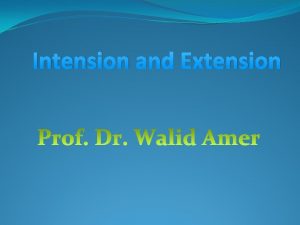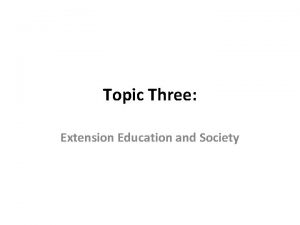ENVIRONMENTAL AND SOCIAL IMPACT ASSESSMENT FOR THE EXTENSION



























































- Slides: 59

ENVIRONMENTAL AND SOCIAL IMPACT ASSESSMENT FOR THE EXTENSION OF MANGOCHI POTABLE WATER SUPPLY PROJECT PRESENTATION OF THE DRAFT ESIA

PRESENTATION PLAN • • • • Objectives Background and Introduction Project activities Consideration of alternatives Legal and Policy Framework Baseline studies Project impacts Positive impacts Adverse impacts-Planning and construction phases Adverse impacts – demobilization/ operation Environmental and social management plan Environmental and social monitoring plan Conclusion and recommendations

Objectives

The objectives of this presentation are: • Presentation of the Final Draft ESIA Report • Collect concerns, comments etc. for finalisation of the ESIA

Background and Introduction

PROJECT DEVELOPER, FUNDING AND SCOPE • Project is the Southern Region Water Board (SRWB) • SRWB has acquired funding from Kuwait Fund for Arab and Economic Development (KFAED) • The funding is through the Government of Malawi • to extend Mangochi water supply system to: • • lakeshore areas. un-served areas along the Lakeshore from Mpondasi to Mtakatata Turn-Off cover the trading centres of Namiasi, Maldeco, Makawa, Mtakatata Turn-Off holiday resorts along the lake. • The project has a design horizon extending up to the year 2035

PROJECT GOALS/ OUTCOMES • To benefit an estimated population of about 92, 847 who currently get water from unsafe sources such as hand-pump boreholes, shallow wells, rivers, Lake Malawi etc. • This will reduce the high prevalence rate of water related (waterborne and water-wash) diseases

JUSTIFICATION FOR THE PROJECT • Areas surrounding Mangochi Town, particularly those around the shores of Lake Malawi are experiencing significant settlement growth • are in critical need of reliable safe water supply • Communities in these areas draw water directly from the lake without treatment and are very much affected with water borne diseases especially among under five children whose mortality rate is estimated at 18% • presence of reliable water supply in terms of quality and quantity from a mandated organisation such as the SRWB will promote tourism in Mangochi Lakeshore area • Hence, leading to economic empowerment of the locals

PROJECT LOCATION • Mangochi District • The three submersible pumps about 300 m into the Lake from Nkhudzi Hill • A conventional surface water treatment plant will be at 1 km North. West of Nkhudzi Bay intake, on a flat area overlooking Nkhudzi Hill • A reinforced concrete tank of 4, 000 m 3 at Nkhudzi Hill to receive treated water • Water to from the clear water tank to Ntaka turn off and Bishop’s house near Mangochi Town • A 500 m 3 tank at Namiasi and communal water points in various areas

GOALS AND OBJECTIVES OF THE ESIA • To study and understand the project activities • To establish and update the bio-physical and socio-economic baseline related to the project • To assess the flora and fauna present in the area • To assess the social and economic state of the project area • To assess the cultural heritage and archaeological state site • To review the policies, regulations, standards, administrative records that relate to sustainable management of resources • To Identify environmental, social and cultural impacts of the project activities • To determine appropriate mitigation measures for the identified impacts • To provide recommendations

METHODOLOGY USED FOR ESIA PREPARATION • Literature review • Stakeholder engagement process • (KIIs SRWB, Government Departments and Agencies at Mangochi District Council) • FGDs in the communities affected directly or indirectly by the project • Household surveys • Analysis of the socio-economic and water quality/ quantity data • Analysis of project activities against the baseline data • Identification of beneficial and negative impacts. • Determination of mitigation measures

Project activities

PROJECT PLANNING AND DESIGN ACTIVITIES • Plan, prepare and implement all compensations in coordination with the Mangochi District Commissioner and the Department of Lands. • Conduct sensitization and awareness on the need for land for the project and the compensation process • Strengthen the Grievance Redress Mechanism used in other projects for use in this project • Sensitize the affected people to use the existing Grievance Redress Mechanism • Acquire land through ‘owner offers, SRWB agrees and pay’ process, with the involvement of the Mangochi District Lands Office and the Regional Physical Planning Department Office (South) • So far, an agreement has been made with four (4) Project Affected Persons for compensation for land for proposed pump house.

PROJECT CONSTRUCTION ACTIVITIES • Construction of the intake structure at the Lake at Nkhudzi Bay • Construction of a conventional water treatment plant comprising of clarifiers, pressure filters and chlorine dosing equipment • Construction of transmission pipelines • Construction of two service reservoirs, at Nkhudzi Hill and at Namiasi • Construction of distribution pipe network, which will extend up to Mtakatata Turnoff and construction of 15 New Communal points • Procurement of materials for new water connections. • Construction of auxiliary buildings (A block to house a laboratory, the chemical dosing/storage rooms and the dosing pumps and three houses). • Construction of a 3 km, 5 m wide the access road to the treatment plant

PROJECT DEMOBILISATION ACTIVITIES • Removed of temporary works and structures after their use: • • • temporary fences and barriers workers’ camps scaffolding material work site signs posts steel cuttings and material stockpiles The construction sites will be cleared and the affected areas will be appropriately restored.

PROJECT OPERATION ACTIVITIES • Boosting water from Mpondas to Namiyasi Trading Centre • Water abstraction and pumping from the intake at the Lake, at Nkhudzi Bay • Operation of a conventional water treatment plant for clarification, pressure filtration and chlorination • Operation of two service reservoirs, at Nkhudzi Hill and at Namiasi (Contrlling water levels, opening and closing valves) • Operation of the distribution pipe network and provision of new water connection • Setting up of WUAs for the 15 CWP and training them • Equipment to support day-to-day management of the project • Maintenance of the equipment and infrastructure for efficient delivery of the services • Running of offices and administration work

LABOUR, EQUIPMENT AND MATERIAL INPUTS SN Inputs (Equipment or material) TO BE PROVIDED BY THE CONTRACTOR 1 Crawler Dozer 2 Backhoe excavator 3 Trench compactor 4 Concrete mixer 5 Tippers and trucks 6 Vibrating pokers 7 Carpentry tools 8 Plumbing and brick laying tools TO BE SOURCED LOCALLY 9 Fine and course aggregate 10 River sand gravel 11 Cement 12 Water 13 Reinforcement metal bars 14 Cement bricks 15 Pipes and fittings 16 Hypochlorite solution 17 Raw water 0. 157 m 3/s 18 Labour (approximately 1000) for all stages Use of the equipment or material Access roads and clearing Pipe trenches Trench Compaction Mixing concrete Transportation of materials Concrete compaction For carpentry works For pipe and brick laying works Concrete formulation and water filtration Concrete formulation and other construction Concrete formulation and construction works Concrete reinforcement For various construction structures For water pipelines For water treatment From Lake Malawi (At least 45% will be local casuals; and up to 30% women)

MANAGEMENT OF WASTE • Backwash wastewater will be settled to remove suspended solids before discharging into the environment (Cl 2 < 1 mg/l; for MBS limit) • Sludge from the clarifiers will be thickened, dried on evaporation beds and will be offered to local farmers as manure. • Construction waste will be managed in liaison with the District Council • Human waste will be managed by pit latrines and waterborne toiltes

Consideration of alternatives

CONSIDERATION OF ALTERNATIVES • “no action” alternative will: Deny potable water to new developments and lodges. Force people to continue to use unsafe water sources Mean continuation of water related diseases and cholera outbreaks Mean communities will continue to spend productive time on water Increase under-five mortality rates currently at 18% for the project area, mostly due to diarrhoeal and water-related diseases would. • Deny potential revenue to SRWB and Govt. • Mean school girls will be denied conducive environment to do well in schools. • • •

CONSIDERATION OF ALTERNATIVES (cntd. ) Water source and intake alternatives • Water from the boreholes is of poor quality due to excess calcium • Rivers (e. g. Koche and Shire) have low water flows during dry season • Geological stability of the area • Exposure of the area to strong winds, wind action and turbulence • Accessibility to the potential intake areas during construction and operation activities • Distance to the existing power lines. • Access for pipeline construction from the intake • Encroachment into the residence (e. g. encroachment to Dr Banderson’s) • THE PREFERRED OPTION MEETS THE ABOVE CRITERIA

CONSIDERATION OF ALTERNATIVES (cntd. ) Other alternatives • Steel and duct iron pipes are stronger and last longer than u. PVC pipes. Hence, they do not easily burst, minimising non-revenue water. • The intake pipeline positioning will avoid fish (especially mbuna). • Pressure filters preferred (easy to use, compact, small productions)

Legal and Policy Framework

Policy and Legal Framework National Legal Framework • National Water Policy • National Environmental Policy • HIV and AIDS Policy • Land Policy • Sanitation Policy • Forestry Policy • Parks and Wildlife Policy • Gender Policy • Cultural Policy

Policy and Legal Framework • • • Water Works Act Water Resources Environment Management Act Local Government Act Land Act Customary Land Act Lands Acquisition and compensation Act Gender Equality Act Physical Planning Act Occupational Safety Health and Welfare Act Forestry Act Parks and Wildlife

Policy and Legal Framework • Gender Equality Act • National Parks and Wildlife (Amendment) Act • Monuments and Relics Act Guidelines for Environmental Impact Assessment • Guidelines for Water Sector Projects • Malawi Growth and Development Strategy III • Environment Management (Waste Management and Sanitation) Regulations • Environment Management (Waste Management (Plastics) Regulations

Regulatory licences No Regulations/ Standards/Approvals Description Reference Issuing Institution 1 Environmental Certificate Environmental and social protection EMA, 2017 and EIA Guidelines 1997 EAD 2 Water Abstraction Permits water abstraction of groundwater or surface Water Resources Act (2013) Water Resource Authority 3 Approval of the project design Project to meet planning requirements Mangochi District Council by-laws; and the Physical Planning Act (2016) Mangochi District Council 4 Planning permit Conform to the District Council development plans. Local government Mangochi District Council 5 Workplace Registration Certificate Regulates workers safety and health Occupational Safety Health and Welfare Act (1997) Ministry of Labour Youth Sports Manpower Development 6 National Parks and Wildlife permit Controls the use of national parks and wildlife National parks and wildlife (Amendment Act, 2017) Ministry of Forestry and Natural Resources 7 Title deeds Proof for land ownership Lands Act 2016 Ministry of Lands 8 Antiquities Clearance Certificate Proof that CHIA was conducted Monuments and Relics Act and Antiquities Policy Department of Museums and Monuments

Relevant Environmental Standards Standard Title MS 214: 2013 (second Revision) Drinking Water – Specification MS 714: 2005 Occupational Safety and Health Management Systems Specification MS 719: 2005 Hazardous Waste – Management, Classification and Disposal – Code of Practice MS 59: 2002 Solid waste – handling, transportation and disposal – code of practice MS 730: 2005 Solid waste disposal sites, guidelines for design MS 539: 2013 Industrial effluents- Tolerance limits for discharge into inland surface waters

Relevant international policies • UNESCO World Heritage Convention concerning the Protection of the World Cultural and Natural Heritage • 2003 UNESCO Convention on Safeguarding of the Intangible Cultural Heritage

Baseline studies

PHYSICAL CHARACTERISTICS • Climate (rainfall and temperature) • Topography and soils • Land use patterns • Settlement patterns • Geology • Hydrology

BIOLOGICAL CHARACTERISTICS • Flora • Tree density estimates 23 • Fauna • A total of fifty (50) bird species were recorded from the study area. No threatened or endemic bird species was recorded • A total of twenty (22) mammal species were recorded. There were neither threatened nor endemic mammals species • A total of seventeen (17) reptile species were recorded from the study area. No threatened or endemic reptile species was recorded • A total of ten (10) amphibian species were recorded. No threatened or endemic amphibian species were recorded

BIOLOGICAL CHARACTERISTICS (CNTD) • Fish • A total of 7 fish species namely; Labeo mesops (Ntchila), Oreochromis lidole (Chambo), O. karongae (Chambo), Tilapia shirensis (Makumba), Haprochronis sp. , (Kambuzi), Barbus paludinosus (Matemba) and Claris liocephalus (Mulamba) were recorded from the waters of Nkhudzi Bay where the new Intake will be constructed. • One fish species Oreochromis karongae (chambo) was recorded. • No alien fish species was surveyed or spotted and/or recorded from the project area • No alien fish species was reported to occur in the project area by other researchers

SOCIO-ECONOMIC SETTING • The population of Mangochi district was 1, 148, 611 in 2018 • The project covers areas from Mangochi Boma to Mtakatata Turn Off, both of which are part of TA Mponda has a population of 167, 313 (NSO Report 2018) • SRWB plans to supply water within the stretch targeting a population of 92, 847 by the year 2035 • Specifically, the project will supply water to the following villages: Chidzula, Nakumba, Makawa, Chipala, Mtimbula, Michesi, Ntyala, Chipoka, Ngoyi, Sanimkawa, Mpondasi and Masanga. • SRWB also intends to supply water to the following Trading Centres: Maldeco, Namiasi and Makawa.

SOCIO-ECONOMIC SETTING (CNTD) • From the household survey • 45. 3% of the sampled population belong to the Yao tribe. Following the Yao are the Chewa (17. 2), then the Lomwe (16. 3%), and other ethnic groups in smaller numbers • 53. 9% are Christians, seconded by the Islamic faith comprising of 46. 0% • Most people in the project area practice matrilineal system of marriage where the husband moves to the wife’s house/village • Chieftainship is handed down from one generation to another, with the heir being a nephew or niece usually coming from one of the chief’s sisters • Children have to undergo initiation ceremonies known as Jando for boys and Nsondo for girls at puberty • There were no initiation sites recorded in the project site • Overall, the observation of cultural rites is slowly diminishing due to modernization, inter-mariage across tribes and access to better education

HISTORICAL AND ARCHAEOLOGICAL CULTURAL HERITAGE • 12 sites of archaeological and cultural interest and 3 grave sites were identified within the project impact zone No 1 Name of site MH-Nkhudzi 1 Archaeological Site 2 3 4 5 MH-Nkhudzi 2 Archaeological Site MH-Nkhudzi 3 Archaeological Site MH-Nkhudzi 4 Archaeological Site MH-Nkhudzi 5. Rock Art Site 6 MH-Nkhudzi 6 Namalowe sacred sitepotential grave site MH-Nkhudzi 8 Potential Grave Site MH-Nkhudzi 11 Grave site and Sacred site I 7 8 9 10 11 MH-Nkhudzi 12 Sacred Site III MH-Nkhudzi 14 Archaeological Site Description Potential Iron Age site, with concentration of potsherds, some decorated with rims intact. Situated near Flanzilo cottage. Potential historical site with scatters of embedded weathered pottery and iron implements. Potential iron age settlement with concentration of embedded decorated pottery. Iron Age site along a pathway with embedded decorated potsherds. A massive rock shelter with ancient rock art (combination of red and white paintings). Need detailed survey within the vicinity to locate more rock art sites. Pottery, bones and shells were also recorded at the site This site is located in a cluster of hills near Mwanyama Village. According to local informants, the site was used to bury dead people from the Mwanyama village. This is a potential burial place along the proposed access road to the water tank. Recommended for test excavation with exhumation and relocation follow-ups. This site is under Ndondwa tree and Chilusa tree, this was the oldest grave where the first Chief, Group Village Headman Mwanyama was buried. Adjacent to this grave site is a sacred site, under the Ndondwa tree where traditional sacrifices used to happen A sacred site where in the past local people used to offer sacrifices. The site no longer used for traditional practices A sacred site where local used to offer sacrifices under a Nsangu tree. The site no longer used for traditional practices Potential iron age site, with scatters of potsherds. Need further subsurface investigations.

LIVELIHOOD AND INCOME • From the household survey: • informal employment and businesses (trading), are the major sources of income and livelihood support with 32. 2% and 31. 5% respectively. 11. 4% of the population within the project areas rely on fishing for income. • Monthly income is less than MK 10, 000 for 43. 7% of the population and MK 10, 000 to MK 25, 000 for 28. 9% of the population

EDUCATION • Results from socio-economic survey shows that the highest level of education for majority of the people is primary level at 51%. • 15. 8% attended school up to secondary level as shown in • School enrolment has increased over the past 5 years in the district • Dropout rates are still high, especially for girls between standard 5 and 8. Early pregnancies and marriages, lack of good parental care and technology i. e. increase in video shows in the district are the major causes of increase in dropout rates. • Shortage of learning materials, qualified teachers and lack of sanitation and hygiene facilities for girls are impediments to quality education for the students • Cost (tuition and other fees), materials for learning and distance are some of the challenges that communities face in accessing education

HEALTH SITUATION IN THE PROJECT AREA • The leading cause of morbidity in Mangochi district is malaria, followed by acute respiratory infections • Malaria incidents in the district decreased from 31% in 2016 to 26% in 2017 due to mass distribution of Long Lasting Insecticidal Treatment Nets (LLINs). However, malaria still remains the cause of high death rate among children under the age of 5 • According to the household survey, malaria (38%), chronic respiratory infections (32%) and diarrhoea (17%) are the common diseases in the project area

COMMON DISEASES THE PROJECT AREA • HIV and AIDS is one of the major communicable disease in the district • Sexually transmitted infections (STIs) are also common in the district. Due to unsafe sex practice which is common. • Cholera and diarrhoea also pose major problems in the district due to low access to safe water and improved sanitation • For most people residing in the project areas, distance to the nearest health care service is less than 30 minutes (56 %), a few people reported having to walk a distance of more than 2 hours (5%) to access the nearest health care services

WATER AND SANITATION IN THE PROJECT AREA • From the household survey, boreholes are the major source of drinking water in the area at 43. 3%. • 31. 3% use piped water (tap) • 20. 9% use lake/ river/ streams • The household survey showed that 60% of the population use traditional pit latrines and only 1% use flush toilets

Project impacts

PROJECT POSITIVE IMPACTS • Employment opportunities • Improved water supply to Mangochi Town and the surrounding areas • Improved sanitation, hygiene and health • Improved socio-economic situation of the communities • Increase in revenue generation • Education benefits to the girl child

ADVERSE IMPACTS – PLANNING/ CONSTRUCTION • Loss of land assets • Dust generation • Land degradation and soil erosion • Loss of vegetation cover, aesthetic scenery and disturbance or loss of wildlife • Exposure of people and animals to injuries and accidents • Disruption of water supply • Water pollution and siltatio • Potential increase in poaching

ADVERSE IMPACTS – CONSTRUCTION (CNTD) • Increase in spread of Sexually Transmitted Infections (STIs), HIV and AIDS, unplanned pregnancies and breaking up of families • Increased pressure on community health services • Increased COVID – 19 infections and related deaths • Sexual abuse and harassment • Unequal employment • Child labour and trafficking • Gender Based Violence (GBV) and Violence Against Children (VAC)

ADVERSE IMPACTS – DEMOBILIZATION/ OPERATION • Loss of jobs and businesses • Solid waste generation • Increased pollution from wastewater and sludge • Increase in water leakage • Destruction of archaeological and cultural/ historical heritage sites • Impacts on the Outstanding Universal Value (OUV), integrity, protection and management of Lake Malawi National Park (LMNP) as a World Heritage Site

Environmental and social management and monitoring plans

ENVIRONMENTAL AND SOCIAL MANAGEMENT PLAN (ESMP) • Provides measures to be taken, to ensure that the identified impacts of the Project are mitigated through the following hierarchical order: • Avoiding activities that could result in adverse impacts and avoiding resources or areas considered as sensitive; • Preventing the occurrence of negative environmental impacts and/or preventing such an occurrence from causing negative environmental impacts; • Preserving resources by extending the legal protection to selected resources beyond the immediate needs of the project; • Minimizing the impact by limiting or reducing the degree, extent, magnitude or duration of adverse impacts through scaling down, relocating and/or redesigning elements of the project; • Rehabilitating, repairing or enhancing affected resources, such as natural habitats or water sources, particularly where previous developments have resulted in significant resource degradation; • Restoring affected resources to an earlier and more stable productive state (background / pristine condition); and/or • Compensation by provision of the same type or better resource/ property at another suitable and acceptable location, compensating for the lost resources/ property.

The ESMP presents • Potential beneficial and adverse environmental and social impacts of the project • Enhancement measures for the beneficial impacts and the mitigation measures for the adverse impacts. • Responsible institutions to implement the mitigation measures. • Estimated cost for implementing the measures. • Time frames for implementation of the mitigation measures. Southern Region Water Board and the Contractor have the responsibility of ensuring that the ESMP is implemented effectively and fully.

EXAMPLE OF CONTENTS OF THE ESMP ID Potential Impact Recommended enhancement/mitigation measure 1. 1. 1. ENHANCEMENT MEASURES FOR BENEFICIAL IMPACTS Construction phase Creation of employment Inform local communities of employment opportunities Prioritise employment of local persons that qualify. Treat workers well, pay them fairly (above the minimum wage) and pay overtimely. Sensitise workers to save and invest during project implementation. 1. Increase in trade opportunities Schedule for implementation Responsible institution Continuously throughout construction Contractor, District Labour Officer, District Community Development Officer Pay materials suppliers within the agreed times. Quarterly Source materials from licenced suppliers. Support and promote of entrepreneurship skills amongst the communities and business people in the project area by engaging them where appropriate. Promote village savings and loan (VSL) schemes during project implementation. Contractor, District Community Development Officer Implementation cost/year (MKW) 4, 761, 640. 00 Cost included in 1. 1. 1

COST FOR THE ESMP S/N Potential Impacts 1 2 3 4 5 6 7 8 9 Creation of employment opportunities Improved sanitation, hygiene and health Enhanced gender and women participation in development Loss and compensation for land assets Loss of vegetation cover, aesthetic scenery and disturbance or loss of wildlife Noise and vibrations Occupational incidents and accidents Potential increase in poaching Increase in spread of Sexually Transmitted Infections Total Implementation cost in MKW/Year 4, 761, 640. 00 9, 523, 280. 00 3, 662, 800. 00 9, 076, 752. 00 2, 500, 000. 00 7, 325, 600. 00 1, 800, 000. 00 7, 325, 600. 00 55, 498, 952. 00

BUDGET FOR MITIGATION MEASURES OF HERITAGE RESOURCES AND WORLD HERITAGE ATTRIBUTES Contractor Training and Awareness Program 7, 000. 00 Archaeological monitoring of land transformation activities 5, 500, 000. 00 Salvage excavations and subsurface investigation 7, 500, 000. 00 Post excavation laboratory analysis of recovered artefacts 5, 000. 00 Chance Find Procedures 5, 000. 00 Grave exhumation and relocation 4, 000. 00 Monitoring the implementation of mitigation measures of World Heritage Attributes: Planting of trees and grass, provision of drainage systems, fences, rehabilitation of borrow pits, 11, 000. 00 45, 000. 00

ENVIRONMENTAL AND SOCIAL MONITORING PLAN • Provides for monitoring to check the implementation of the enhancement and mitigation measures proposed in the ESMP • It identifies the roles and responsibilities of stakeholders monitor; and the estimated cost of the monitoring activities. • It provides monitoring indicators, means of their verification and the frequency of monitoring • It helps to verify the magnitude, duration and scope of the predicted impacts during and after implementing the enhancement and mitigation measures. • It also helps to detect any unforeseen impacts at an early stage so that corrective measures can be taken, before significant damage takes place on the social, economic and biophysical components of the environment.

EXAMPLE OF CONTENTS OF THE MONITORING PLAN ID Potential Impact Recommended enhancement/mitigation measure Monitoring indicator Means of monitoring Monitoring frequency Responsibility for monitoring 1. Child labour and trafficking Employ people who have genuine identification to prove that they are 18 years old and above Age of employees Inspection, Review of employee files Quarterly Employ workers through established recruitment agencies Number of employees from established recruitment agencies Availability of an accurate register Interviews Contractor, District Labour Office, District Social Welfare Office Maintain an accurate staff register against which employee presence must be checked every day Inspection and interviews Monitoring cost (MKW)/ Year Included in 2. 2. 7

COST FOR MONITORING ACTIVITIES S/N 1 2 3 4 5 6 7 8 9 10 11 12 13 Potential Impact Creation of employment opportunities Improved water supply to Mangochi Town and the surrounding areas Improved sanitation, hygiene and health Improved socio-economic situation of the communities Increased development Losses and compensation for land assets Dust generation, gas and particulate matter emission Disruption of water supply, Water pollution and siltation Occupational incidents and accidents Disturbances and accidental damage to assets Increase in sexual relationships Diseases and increased pressure on community health services Loss of jobs and businesses Total Cost in Mk per Year 293, 024. 00 73, 256. 00 293, 024. 00 879, 072. 00 293, 024. 00 73, 256. 00 5, 127, 920. 00

Conclusions and recommendations

CONCLUSION • The project for the proposed rehabilitation, upgrading and expansion works for Mangochi Water Supply System will generate environmental, social and cultural heritage impacts • Most of the significant impacts will be positive in nature, and these will mainly be social, economic and health impacts, resulting from increased and improved water supply • Most of the negative impacts will be moderate to minor in nature and most of them will be short to medium term • The identified negative impacts can be managed by implementing the mitigation measures recommended in the ESMP

RECOMMENDATIONS • To ensure satisfactory achievement of environmental and social sustainability in the implementation of the proposed project, the following recommendations are made: • Water abstraction has to be in accordance to the Water Right, which SRWB will be required to obtain before the project can be implemented. • The project should be fully supported by all the relevant institutions; • Adequate financial support should be allocated to realise the full potential to improve the socio-economic wellbeing of the targeted communities; • The environmental and social impacts should be avoided or minimised to the greatest extent possible by fully implementing the enhancement and mitigation measures advanced in this report; • SRWB must conduct adequate sensitization on water supply pricing and management to ensure that the communities fully understand how they calculate the water tariff. • SRWB must allocate additional funds for corporate social responsibilities to improve its image among the communities, • During construction, the contractor should avoid clearing any protected or endangered plant species. • Adequate and fair compensation must be given to all the affected people before construction activities start; • SRWB and the respective key stakeholders should support and facilitate employment of women, the youth and vulnerable groups to eliminate potential gender and social imbalances; • Where possible and appropriate, employment of local people from the project area must be prioritised to encourage community ownership and sustainability of the project.

Thank you!
 Mcn 201 sustainable engineering syllabus
Mcn 201 sustainable engineering syllabus Rapid environmental impact assessment in disaster
Rapid environmental impact assessment in disaster Environmental impact assessment
Environmental impact assessment Environmental auditing
Environmental auditing Flanker brand strategy
Flanker brand strategy Environmental science sustaining your world answers
Environmental science sustaining your world answers Ipat model
Ipat model Whats the domino theory
Whats the domino theory Ipat model
Ipat model Ipat model
Ipat model Environmental effects of tidal energy
Environmental effects of tidal energy Environmental impact of cnc machining
Environmental impact of cnc machining Mh 605
Mh 605 Pay for success bonds
Pay for success bonds Business impact analysis vs risk assessment
Business impact analysis vs risk assessment Cipd
Cipd Viscoroute
Viscoroute Change impact assessment template
Change impact assessment template Event impact assessment
Event impact assessment Labour market impact assessment lmia online web application
Labour market impact assessment lmia online web application Mental wellbeing impact assessment
Mental wellbeing impact assessment Mental wellbeing impact assessment
Mental wellbeing impact assessment Regulatory impact assessment india
Regulatory impact assessment india Social thinking adalah
Social thinking adalah Social thinking social influence social relations
Social thinking social influence social relations Health social and environmental responsibility
Health social and environmental responsibility Social and environmental responsibility grade 11
Social and environmental responsibility grade 11 Cost and management accounting ppt
Cost and management accounting ppt Esj action plan
Esj action plan Positive impacts of ict
Positive impacts of ict Social impact of ict in education
Social impact of ict in education The negative impact of social media on students
The negative impact of social media on students Georgia social impact collaborative
Georgia social impact collaborative Social impact of computers
Social impact of computers Pax romana political impact
Pax romana political impact Social impacts of disaster
Social impacts of disaster Social impact model
Social impact model Social media impact on sleep
Social media impact on sleep Social enterprise pitch deck
Social enterprise pitch deck Description of waste
Description of waste Negative impact of social change
Negative impact of social change Social impact statement for early design review
Social impact statement for early design review Mgd stellenbosch
Mgd stellenbosch Pax romana
Pax romana Social impact statement for early design review
Social impact statement for early design review Chapter 2 environmental science
Chapter 2 environmental science Environmental management system at tcs
Environmental management system at tcs Chapter 2 assessment environmental science
Chapter 2 assessment environmental science Fda environmental assessment
Fda environmental assessment Workplace environmental assessment
Workplace environmental assessment Environmental risk assessment veterinary
Environmental risk assessment veterinary Cdc legionella environmental assessment form
Cdc legionella environmental assessment form Formuö
Formuö Typiska drag för en novell
Typiska drag för en novell Nationell inriktning för artificiell intelligens
Nationell inriktning för artificiell intelligens Vad står k.r.å.k.a.n för
Vad står k.r.å.k.a.n för Shingelfrisyren
Shingelfrisyren En lathund för arbete med kontinuitetshantering
En lathund för arbete med kontinuitetshantering Personalliggare bygg undantag
Personalliggare bygg undantag Personlig tidbok för yrkesförare
Personlig tidbok för yrkesförare
